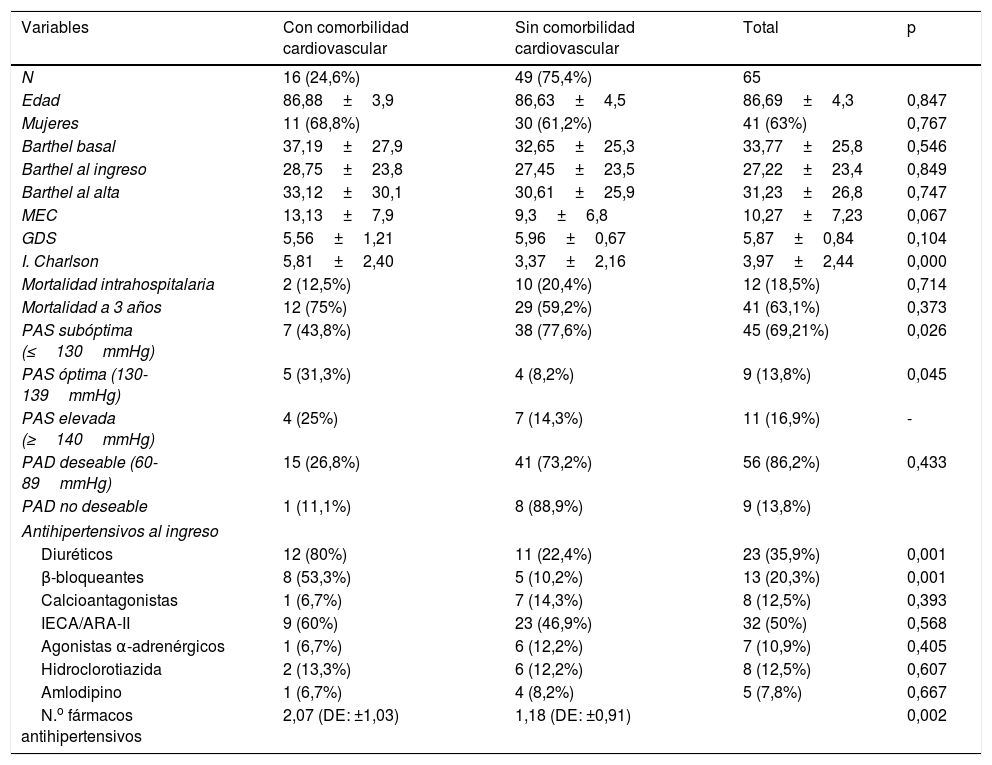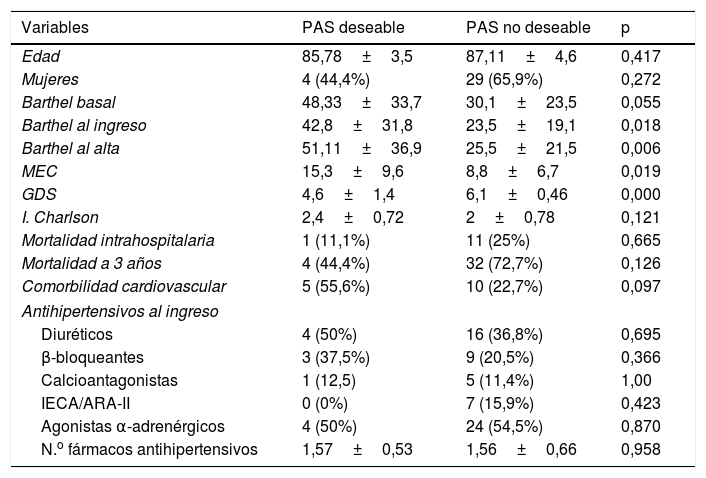Determinar el control de la presión arterial sistólica (PAS) de forma retrospectiva según las recomendaciones de la guía ESC/ESH-2018 y su probable asociación con la mortalidad en pacientes octogenarios con demencia.
Pacientes y métodosEstudio preliminar, longitudinal, observacional y retrospectivo que incluyó 65 pacientes ≥80 años con diagnóstico de demencia e hipertensión arterial ingresados en una unidad de psicogeriatría durante 2015. Las variables principales fueron: control de la PAS según las recomendaciones de la guía ESC/ESH-2018, considerando PAS deseable (130-139mmHg), PAS no deseable (subóptima <130mmHg, elevada ≥140mmHg) y la mortalidad a 3 años en aquellos pacientes con tratamiento antihipertensivo al alta (n=53).
ResultadosEdad media, 86,7±4,31 años (63% mujeres); dependencia funcional severa (índice de Barthel <40): 67,7%; deterioro cognitivo grave (GDS-Riesberg ≥6): 86,3%; elevada comorbilidad: 49%; mortalidad a 3 años: 41 (63,1%). Los pacientes con hipertensión arterial y comorbilidad cardiovascular presentaron mayor prescripción de antihipertensivos (2,07 vs. 1,18; p=0,002). La mortalidad a 3 años fue menor en aquellos con PAS deseable (44,4%) respecto a PAS no deseable (72,7%), aunque no fue estadísticamente significativo.
ConclusionesEl porcentaje de pacientes en tratamiento con PAS subóptima fue elevado especialmente en hipertensos sin comorbilidad cardiovascular. Encontramos una tendencia a mayor mortalidad en los grupos de PAS no deseable respecto a PAS deseable.
To determine the control of systolic blood pressure (SBP) retrospectively according to the recommendations of the ESC/ESH-2018 guideline and its relationship with mortality in octogenarian patients with dementia.
Patients and methodsPreliminary, longitudinal, observational, retrospective study, including 65 patients ≥80 years with diagnosis of dementia and arterial hypertension admitted to a psychogeriatric unit during 2015. The main variables were SBP control according to the recommendations of the ESC/ESH-2018 guideline, considering desirable SBP (130-139mmHg), undesirable SBP (suboptimal <130mmHg and elevated SBP ≥140mmHg) and mortality at 3 years in patients with antihypertensive treatment at discharge (n = 53).
ResultsMean age, 86.7±4.31 years (63% women); severe functional dependence (Barthel index <40): 67.7%; severe cognitive impairment (GDS-Riesberg ≥6): 86.3%; high comorbidity: 49%; mortality at 3 years: 41 (63.1%). Patients with arterial hypertension and cardiovascular comorbidity had a higher prescription of antihypertensive drugs (2.07 vs. 1.18, p=.002). Three years mortality was lower in patients with desirable SBP (44.4%) versus undesirable SBP (72.7%) groups, although it was not statistically significant.
ConclusionsThe percentage of patients in treatment with suboptimal SBP was elevated especially in hypertensive patients without cardiovascular comorbidity. We found a trend for higher mortality in undesirable SBP groups compared to desirable SBP.










